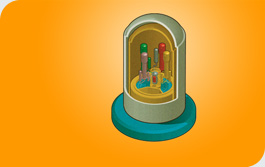
The French Nuclear Safety Authority (ASN) has just told EDF that it was to remove its reservations with regard to the architecture of the digital Instrumentation and Control (I&C) system of the Flamanville 3(FA3) EPR™ reactor. With regard to its certification, the ASN requested additional information about its architecture. As a consequence, AREVA put forward adjustments to improve the system’s robustness.
ASN considers that the changes made to the instrumentation and control (I&C) architecture of the Flamanville 3 EPR™ reactor are satisfactory and enable it to lift the reservations it expressed in October 2009. This position is based on the analysis by its technical support organisation, IRSN, and the opinion of the Advisory Committee for nuclear reactors.
“We are proud of the technical work carried out by our teams to meet the expectations of our client and the French safety authority. This decision will corroborate our technical know-how for our international clients, outside France,” declared Claude Jaouen, Director of AREVA’s Reactors & Services activities.
The I&C of the FA3 EPR™ reactor comprises two diversified digital platforms of the latest generation. The AREVA TELEPERM® XS safety platform carries out the necessary functions to protect the reactor should an accident occur. The SIEMENS SPPA-T2000 platform mainly runs the reactor when it is operating normally.
The TELEPERM® XS safety digital Instrumentation and Control system developed by AREVA has already been chosen for 11 types of reactor in 14 countries. It is being installed, or will be installed, in 74 units of 41 separate nuclear power stations. It is currently the only one of its generations to be certified in the United States.
* The term instrumentation and control (I&C) covers the temperature, pressure, etc. sensors; devices which, based on a certain number of input data, produce automatic orders to maintain parameters within authorised limits, or to trigger protection measures such as reactor emergency shutdown; the operator interfaces in the control room (control consoles, alarms, etc.). Because they perform functions that are important for reactor safety, these elements are subject to particularly strict requirements. (Source: ASN)
